Balloon Adventures
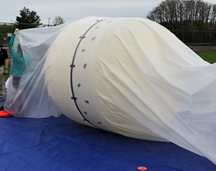
Saturday morning, May 5th 2018, 5:30 am. It is still dark outside, but a few students of the German International School Washington D.C. get out of bed and drive to Shenandoah Junction, West Virginia. An hour later we arrive at the Jefferson High School. At 7:00am, the agreed time, we are still the only ones there. But then, a few white vans with the stickers "Nearspace shuttle" show up at the parking lot.
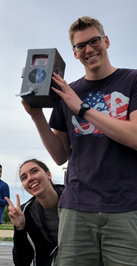
After short greetings among tired faces, students of the University of Maryland lay two plastic tarps on top of one another and set two helium tanks next to them. A still uninflated weather balloon is laid on the upper tarp with latex gloves; the tarp is folded in half and taped together at the edges. Surrounded by the tarp, students begin to inflate the balloon while five boxes are weighed and attached to a rope. Among them is our GISW box, which was prepared earlier in the school year. The boxes are going to measure things like temperature and location. Ours is going to video record the whole flight using a GoPro.
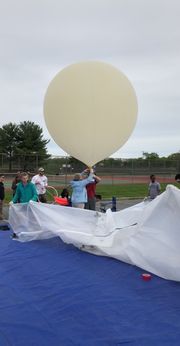
After approximately half an hour of inflation the balloon has gotten too big to stay inside the tarp, so the tape is removed as the balloon continues to be filled in an upright position. The instruments that will measure the data from inside the boxes during the flight are turned on. The GISW stickers on each side of our box cannot be missed of course. The balloon’s intake valve is closed and the tethered boxes are attached.

It is “T minus seventeen” and the clock is ticking. The parachute is being attached to the balloon, but the boxes are still on the ground.
T-15: the rope with the boxes is connected to the balloon.
T-13: the balloon is slowly rising as the boxes hang from the rope.
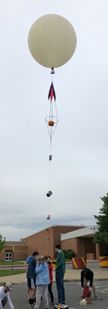
T-10: an upside down umbrella which will be dropped at a certain height later is connected to the end of the rope.
T-9: we take a few selfies with the balloon and its cargo.
T-8: a puff of wind puts the balloon in swaying motion.
T-7: more pictures are taken.
T-6: two students are holding on to the balloon so it does not just float away.
T-5: Tyler Boyle, one of the project managers, is equipped with an antenna to track the balloon and binoculars.
T-3: everything is ready and the balloon is still held on to. We are now just waiting.
T-2: the tension is rising.
T-1: we are standing in a half circle near the balloon, cameras in front of faces.
T-30 seconds: nothing has changed as everyone grins into each other’s cameras.
T-10, 9,…3, 2, 1 the balloon is on the loose. In company of a few goodbye shouts the balloon heads straight up into the sky.
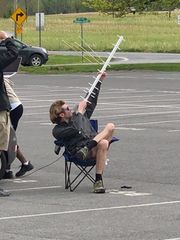
With its chain of boxes attached, the balloon becomes smaller and smaller with the rapid rise in altitude. About two minutes into the ascent, the upside down umbrella is released and falls from the sky which we only see as a dot. A group of students follows the balloon with a car in order to later collect the boxes when the balloon has popped and returned to earth under its parachute. We take final pictures while Tyler points the antenna at the receding balloon before it disappears into the clouds…
The ride back to Potomac is a lot livelier than the drive out to West Virginia. To accompaniment of some good old “schlager”, driving along the Shenandoah River, we make our way back home.
Participants from the GISW at the start of the balloon
Vivien C.
Demetrius D.
Hauke K.
Celina K.
Frederieke S.
Johannes S.
Supervised by:: Susanne Kneiske, Derrick Lampkin and Guido Müller
Report: Frederiecke S.









